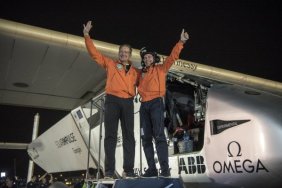After a sketchy first few legs, a solar-plane designed to be the first to circumnavigate the world without a drop of fuel plans to resume its voyage this week.
This most challenging part of this next leg from eastern China to Hawaii puts the extremely light aircraft over the ocean for much of the 120 hours of flight time. Depending on weather conditions, pilot Andre Borschberg, 62, is ready for the trip in Solar Impulse 2, as the plane is called.
Borschberg and fellow Swiss pilot Betrand Piccard are taking turns flying the single-seater aircraft as an effort to promote alternative fuel. There have already been some problems, however, on earlier legs.
High winds of up to 11 knots delayed the landing in the United Arab Emirates, forcing the plane to fly in a holding pattern until they dropped to a safe level. Pilots were held up again on March 31 when weather conditions forced a longer layover on the Yangzte River in southeastern China.
The Solar Impulse 2 can be buffeted by winds since it only weighs about as much as a midsize truck. While it is small, the plan has a wingspan at 235 feet that’s larger than a Boeing 747. Built into those wings are 17,248 solar cells that power four electrical motors and recharge its lithium polymer batteries.
The 120-hour flight from China to Hawaii, far longer than any of the six previous legs, requires the solo pilot to manage fatigue with short naps of no longer than 20 minutes. Goggles worn over the pilot’s eyes will flash lights to wake him up. Special armbands under the flight suit buzz if the plane isn’t flying level, and since the aircraft doesn’t have a pressurized cockpit, the pilot will feel changes of temperature.
The pilot can’t stand in the small cockpit, but the seat reclines for stretching and its cushion is removable for access to a toilet. Monitors constantly check the pilots’ blood oxygen level and relay the readings to ground control.
The aircraft will climb to the altitude of Mount Everest – almost 29,500 feet – during the day to get more sunlight to recharge the batteries and store more energy. At night it flies much lower, at a minimum of 3000 feet. Depending on altitude, the pilot experiences a wide range of temperatures in the cockpit, from 95 degrees Fahrenheit to minus 4 degrees.
With its lightness and wide wingspan, the plane reacts slowly to a change in controls which makes it easy for a pilot to overcompensate. Some aviation experts have mocked the planes slowness. Top cruising speeds are 60-80 mph. But those critics are missing the point. Solar Impulse 2 is trying to prove that a plane can fly around the world without a gas tank and with only the sun’s rays powering it. In theory, it could fly on forever.
Photo credit: Flickr creative commons








